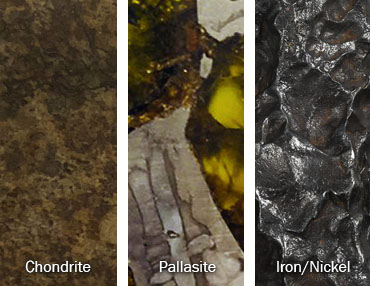
Kesen Chondrite Meteorite
Fukang Pallasite Meteorite
Sikhote-Alin Iron Meteorite
Japan/China/Russia
1850/2000/1947.
Meteorites have many different classifications based on their specific chemical makeup. However, there are three main types that meteorites fall under — stony, stony-iron, and iron. Though some scientists contest where they come from, these are planetary in origin.
As planets of hot gasses and molten material form, they are bombarded by stray fragments as they spin. Over long periods of time, the planet begins cooling as heavier elements consolidate in its center. Thus, the cooler surface is the rocky crust, the center a molten core of iron, and the mantle in between a mixture of both. This differentiation would logically have to take place for there to exist different types of asteroids and meteoroids.
The first and most common meteorite is the stony type. Over 85% of meteorites found are of this variety. These are also called chondrites as they contain material in its unchanged state. Like other meteorites that burn from the friction of our atmosphere as they enter, the outside exhibits a blackened, thin fusion crust. As the surface weathers on Earth, that characteristic color wears away, leaving a stone of similar color to its surroundings.
The next type is the stony-iron meteorite, or pallasite. Less than 2% of all meteorite finds are of this type. These consist of an iron-nickel base with olivine crystals, often nearly evenly divided. These crystals from earthly sources go by the gemstone name, Peridot. When the meteorite is cut into thin slices, the olivine crystals and shiny metallic surfaces make a striking presentation. Etching the iron-nickel inner surfaces with nitric acid will often expose lines called a Widmanstatten pattern. These are kamacite and taenite crystals within the metal. They appear and grow over millions and millions of years during the metal’s cooling in the vacuum of space.
The last major type of meteorite is the iron-nickel. These are likely from the core of a body in space. Most contain approximately 95% iron and 5% nickel, with assorted trace elements. As these jet through our atmosphere, the exposed surfaces melt and create small thumbprint patterns called regmaglyphs.
The specimens acquired by the museum include a chondrite from the 1850 fall in Kesen, Japan, a pallasite from the Fukang fall in China discovered in 2000, and an iron-nickel meteorite from the 1947 Sikhote-Alin fall in Russia.